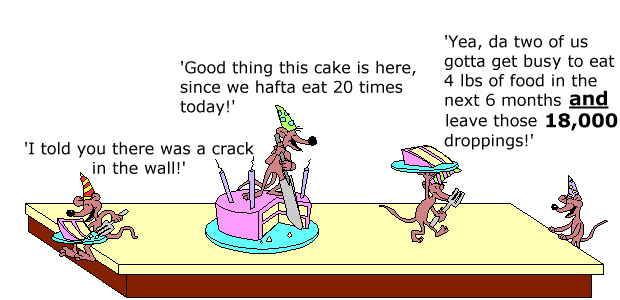 |
| RAT FACTS
Rats are part of a group called commensal rodents. The word commensal means "sharing one's table" which rats and mice have done with humans for years. The two most commonly known rat species of commensal rodents are the Norway Rat, Rattus norvegicus, and the roof rat, Rattus rattus. While house mice are the more predominant rodent problem in most neighborhoods, rats are becoming an increasing problem.
REASONS FOR INCREASED RAT POPULATIONS IN OUR SUBURBAN AREAS States like Arizona in the Sun Belt are experiencing an explosion of roof rat populations. This is caused in part by the human population explosion of the Phoenix area (which experienced a 45.3% increase between 1990 and 2000). These new suburban neighborhoods with irrigated yards, fruit trees and man made lakes in this arid climate have proven a perfect habitat for rats, especially roof rats. Because rats can often live undetected, their populations can increase rapidly before any property damage or rat activity is detected. In some cases, homeowners allow rats 'share' the property so long as they stay outside, but eventually, they loose their good neighbor status. RAT ACTIVITY Norway rats are commonly known as house rats and are often found in burrows on the property. They will find ways into a home to search for food, water, or shelter in some weather conditions. Roof rats are seldom seen on the ground. These rats are extremely agile and often move between trees and buildings like tree squirrels. They can also move easily along telephone lines, power lines, fence tops and tree branches to get from one area of a property to another and throughout the neighborhood. OPTIONS FOR RAT CONTROL The most expensive damage occurs to homeowners when rats enter the home. Exclusion is the first step to control and preventing this damage. This is especially true for homeowners who are part-year residents and come home to find a rat's nest in their toilet or attic.
|

| Back to the Homepage |